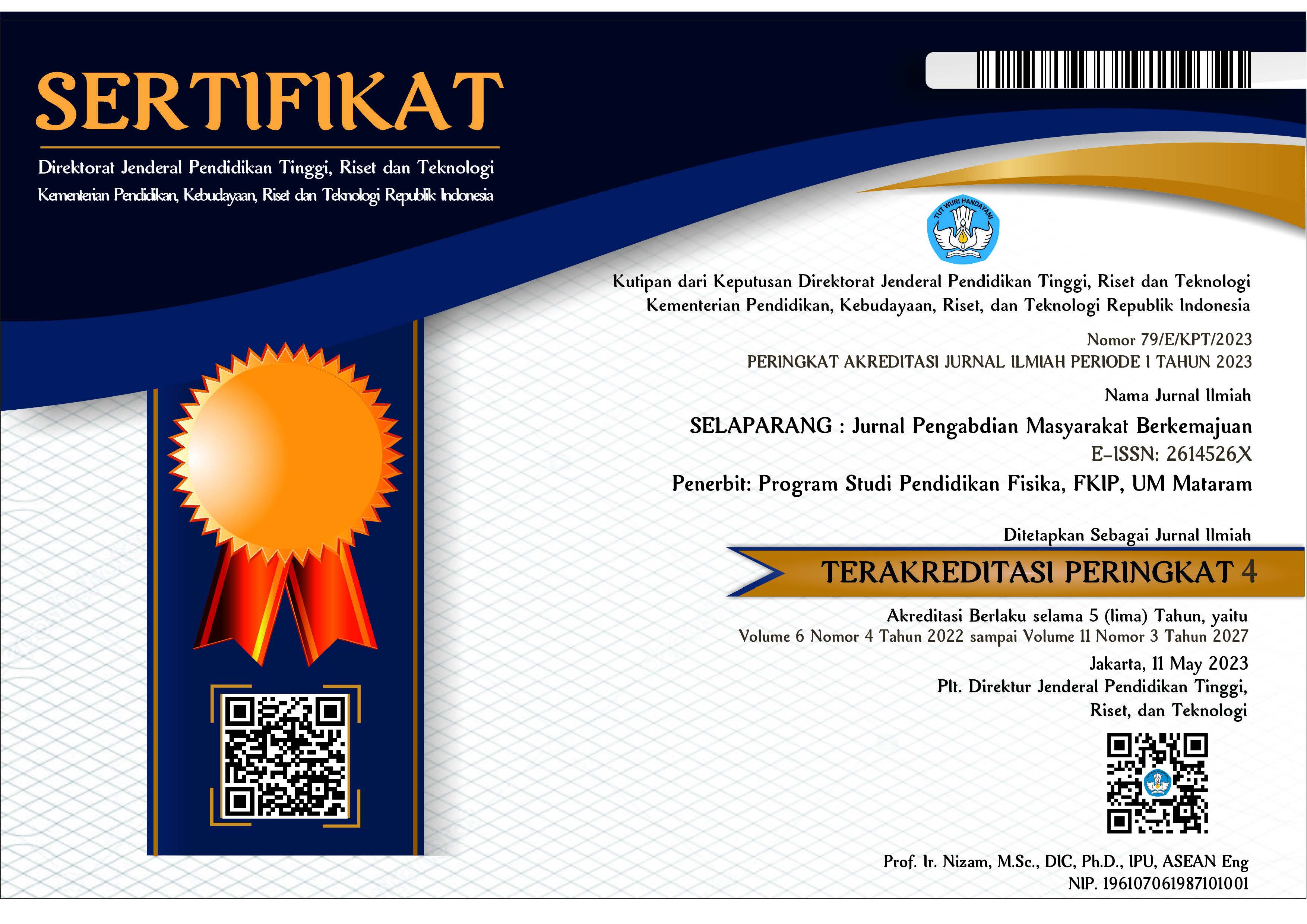EDUKASI IMPLEMENTASI KONVERSI ENERGI MATAHARI MENGGUNAKAN SISTEM PEMANTAU ENERGI DENGAN TEKNOLOGI INTERNET OF THINGS
Abstract
ABSTRAK
Implementasi energi baru terbarukan merupakan alternatif pemanfaatan energi untuk mengurangi penggunaan energi fosil dan mendukung penghematan energi. Edukasi pemanfaatan energi merupakan kebutuhan khususnya pada lembaga pendidikan. Kegiatan PkM dalam menunjang peningkatan pengetahuan tentang konversi energi akan memberikan nilai tambah pada mitra yaitu lembaga pendidikan di tingkat yang berbeda. Tujuan kegiatan PkM adalah memberikan kegiatan edukasi tentang pemanfaatan energi matahari dan angin dalam mengimplementasikan teknologi konversi energi dan pemantauan energi dengan teknologi Internet of Things. Metode pelaksanaan kegiatan PkM dilakukan dengan beberapa tahap yaitu kegiatan sosialisasi materi terkait edukasi sistem pembangkit listrik, kegiatan workshop perakitan PLTS dan pembuatan modul pembelajaran tentang konversi energi dan hibah produk hasil PkM. Hasil kegiatan menunjukkan pelaksanaan terlaksana sesuai dengan rencana dan jadwal yang ditetapkan dan mitra mendapatkan kebermanfaatan dari hasil pelaksanaan PkM.
Kata kunci: konversi energi; pemantauan energi; IoT.
ABSTRACT
The implementation of new and renewable energy is an alternative energy use to reduce the use of fossil energy and support energy savings. Energy utilization education is a necessity, especially in educational institutions. PkM activities in supporting increased knowledge about energy conversion will provide added value to partners, namely educational institutions at different levels. The purpose of the PkM activity is to provide educational activities on the use of solar and wind energy in implementing energy conversion technology and energy monitoring with Internet of Things technology. The method of implementing PkM activities is carried out in several stages, namely socializing materials related to electricity generation system education, PV mini-grid assembly workshops and making learning modules on energy conversion and product grants resulting from PkM. The results of the activity show that the implementation is carried out according to the plan and schedule set and partners benefit from the results of the PkM implementation.
Keywords: energy conversion; energy monitoring; IoT.
Keywords
Full Text:
PDFReferences
Acharya, V., & et. al. (2017). IoT Internet og Things based of efficiency monitoring system of Bio-Gas Plants. 2nd International Conference on Computational Systems and Information Technology for Sustainable Solution (CSITSS).
Ahmed, O. K., Hamada, K. I., & Salih, A. M. (2019). Performance analysis of PV/Trombe with water and air heating system: an experimental and theoretical study. ENERGY SOURCES, PART A: RECOVERY, UTILIZATION, AND ENVIRONMENTAL EFFECTS.
Arora, R., Arora, R., & Sridhara, S. N. (2019). Performance assessment of 186 kWp grid interactive solar photovoltaic plant in Northern India. INTERNATIONAL JOURNAL OF AMBIENT ENERGY, 1–14.
Bencherif, M., & Brahmi, N. (2020). Solar cell parameter identification using the three main points of the current-voltage characteristic. International Journal of Ambient Energy.
Gupta, V., Sharma, M., Pachauri, R. K., & Babu, K. N. D. (2020). A Low-Cost Real-Time IOT Enabled Data Acquisition System for Monitoring of PV System. Energy Sources, Part A: Recovery, Utilization, and Environmental Effects. https://doi.org/https://doi.org/10.1080/15567036.2020.1844351
Hosseini, S. H. (2019). Development of solar energy towards solar city Utopia. Energy Sources, Part A: Recovery, Utilization, and Environmental Effects, 1–14.
Manikandan, P. V., & Selvaperumal, S. (2020). EANFIS-based Maximum Power Point Tracking for Standalone PV System. IETE JOURNAL OF RESEARCH, 1–14.
Mouheb, M., Malek, A., & Loukarfi, L. (2019). Contribution of solar energy for the correction of the voltage drop recorded on a LV power grid in Algeria. ENERGY SOURCES, PART A: RECOVERY, UTILIZATION, AND ENVIRONMENTAL EFFECTS, 1–16.
Negi, P., Pal. Y., & Leena, G. (2020). Stability enhancement of grid connected PV system using model reference adaptive controller. Journal of Information & Optimization Sciences, 41(2), 461–473. https://doi.org/10.1080/02522667.2020.1723940
Rathore, N., Panwar, N. L., Yettou, F., & Gama, A. (2019). A Comprehensive review on different types of solar photovoltaic cells and their applications. International Journal of Ambient Energy, 1–49. https://doi.org/10.1080/01430750.2019.1592774
Raza, M. Y., Wasim, M., & Sarwar, M. S. (2019). Development of Renewable Energy Technologies in rural areas of Pakistan. Energy Sources, Part A: Recovery, Utilization, and Environmental Effects, 1–21.
Stefanie, A., & Suci, F. C. (2021). Analisis Performansi PLTS Off-Grid 600 Wp menggunakan Data Akuisisi berbasis Internet of Things. ELKOMIKA: Jurnal Teknik Energi Elektrik, Teknik Telekomunikasi, & Teknik Elektronika, 9(4), 761–774.
Yadav, S. K., & Bajpai, U. (2019). Energy, economic and environmental performance of a solar rooftop photovoltaic system in India. International Journal of Sustainable Energy. https://doi.org/10.1080/14786451.2019.1641499
DOI: https://doi.org/10.31764/jpmb.v6i2.8292
Refbacks
- There are currently no refbacks.

This work is licensed under a Creative Commons Attribution-ShareAlike 4.0 International License.
______________________________________________________
Jurnal Selaparang
p-ISSN 2614-5251 || e-ISSN 2614-526X
EDITORIAL OFFICE:



















